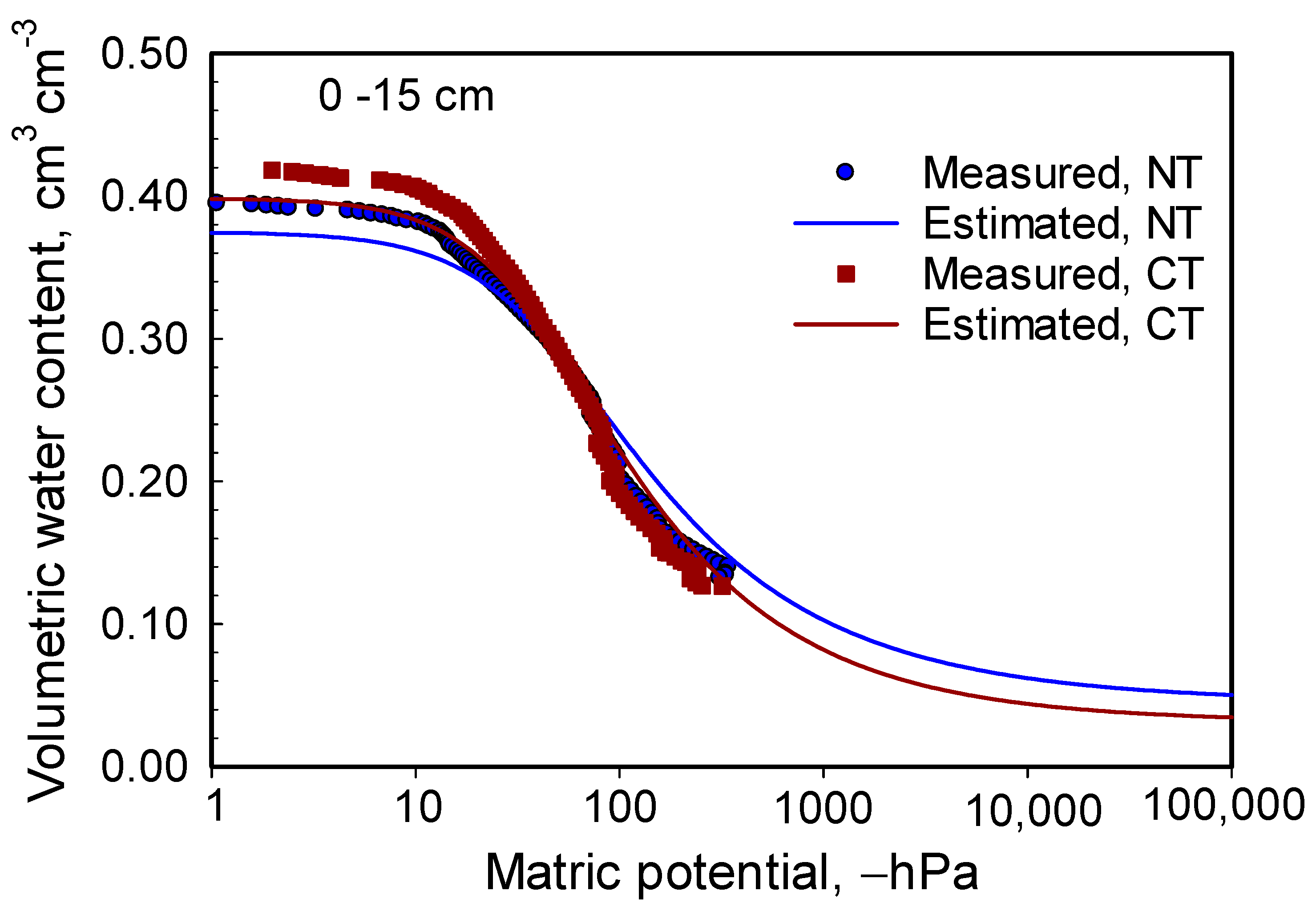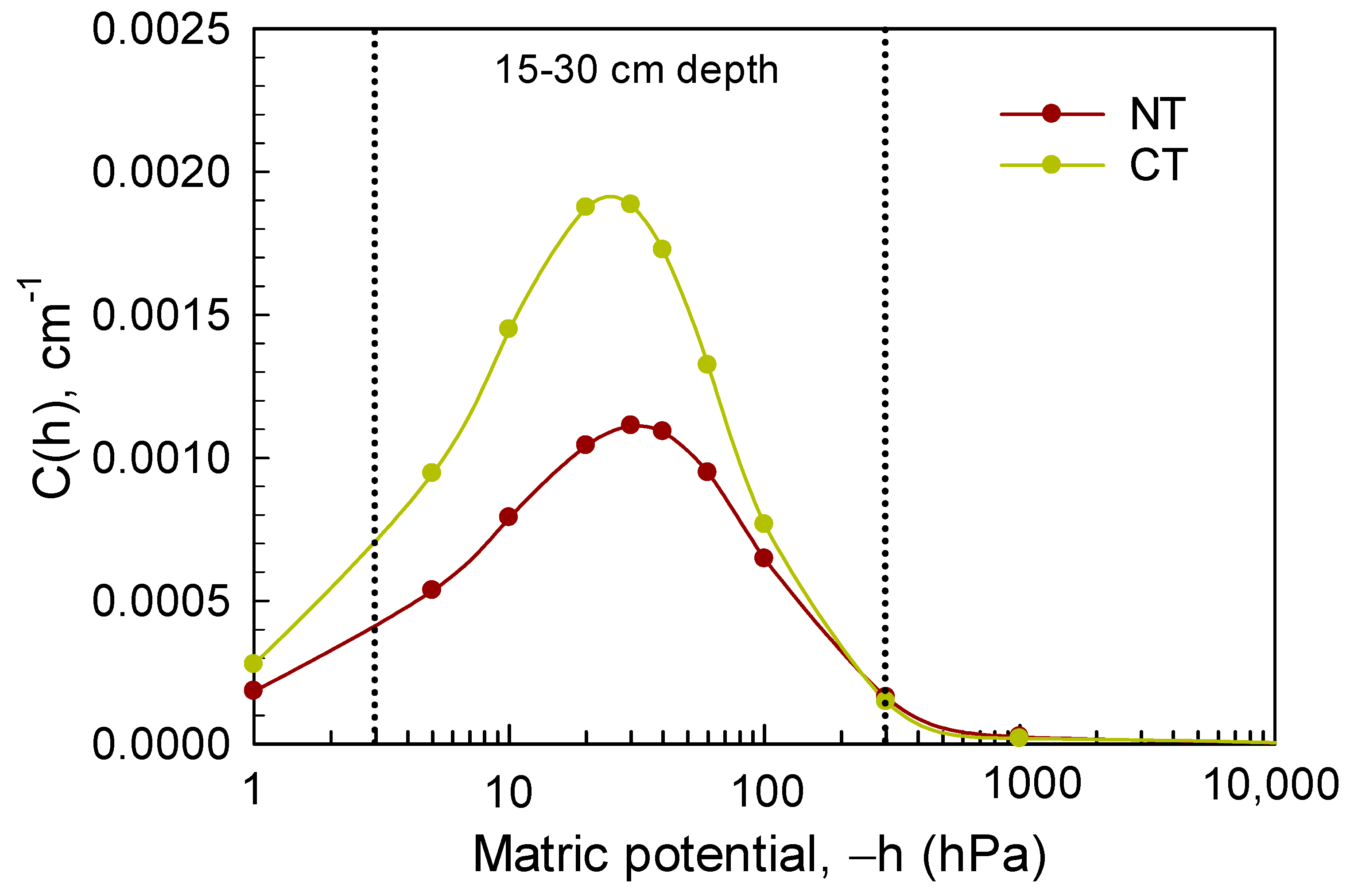Pore Size Distribution Derived from Soil–Water Retention Characteristic Curve as Affected by Tillage Intensity
Abstract
:1. Introduction
2. Materials and Methods
2.1. Site Characteristics and Experimental Design
2.2. Soil Sampling, Sample Preparation, Procedure and Measurement
2.3. The van Genuchten and Capillary Rise Equations
2.4. Statistical Analyses
3. Results and Discussion
3.1. Soil Water Characteristic Curves and Fitting Parameters
3.2. Selection and Estimation of Pore Size Distribution (PSD)
4. Conclusions
Author Contributions
Funding
Institutional Review Board Statement
Informed Consent Statement
Data Availability Statement
Acknowledgments
Conflicts of Interest
References
- Hillel, D. Soil and Water, Physical Principle and Processes; Academic Press: New York, NY, USA, 1971. [Google Scholar]
- Hillel, D. Introduction to Soil Physics; Academic Press: New York, NY, USA, 1982. [Google Scholar]
- Hartge, K.-H.; Horn, R. Essential Soil Physics. An Introduction to Soil Processes, Functions, Structure and Mechanics; Schweizerbart Science Publisher: Stuttgart, Germany, 2016. [Google Scholar]
- Liang, X.; Liakos, V.; Wendroth, O.; Vellidis, G. Scheduling irrigation using an approach based on the van Genuchten model. Agric. Water Manag. 2016, 176, 170–179. [Google Scholar] [CrossRef] [Green Version]
- Jabro, J.D.; Stevens, W.B. Soil-water characteristic curves and their estimated hydraulic parameters in no-tilled and conventionally tilled soils. Soil Tillage Res. 2022, 219, 105342. [Google Scholar] [CrossRef]
- Tuller, M.; Or, D.; Dudley, L.M. Adsorption and capillary condensation in porous media- liquid retention and interfacial configurations in angular pores. Water Resour. Res. 1999, 35, 1949–1964. [Google Scholar] [CrossRef]
- Ahuja, L.R.; Fiedler, F.; Dunn, G.H.; Benjamin, J.G.; Garrison, A. Changes in soil water retention curves due to tillage and natural reconsolidation. Soil Sci. Soc. Am. J. 1998, 62, 1228–1233. [Google Scholar] [CrossRef]
- Bhattacharyya, R.; Prakash, V.; Kundu, S.; Gupta, H.S. Effect of tillage and crop rotations on pore size distribution and soil hydraulic conductivity in sandy clay loam soil of the Indian Himalayas. Soil Tillage Res. 2006, 86, 129–140. [Google Scholar] [CrossRef]
- Kool, D.; Tong, B.; Tian, Z.; Heitman, J.L.; Saur, T.J.; Horton, R. Soil water retention and hydraulic conductivity dynamics following tillage. Soil Tillage Res. 2019, 193, 95–100. [Google Scholar] [CrossRef] [Green Version]
- Wang, H.; Wankui, N.; Xiangning, L.; Lan, L.; Kangze, Y.; Yongpeng, N. Predicting the pore size distribution curve based on the evolution mechanism of soil-water characteristic curve. Environ. Earth Sci. 2022, 81, 23. [Google Scholar] [CrossRef]
- Hill, R.L.; Horton, R.; Cruse, R.M. Tillage effects on soil water retention and pore size distribution of two Mollisols. Soil Sci. Soc. Am. J. 1985, 49, 1264–1270. [Google Scholar] [CrossRef]
- Josa, R.; Gorchs, G.; Ginovart, M.; Sole-Benet, A. Influence of tillage on soil macropores size shape of top layer and crop development in sub-humid environment. Biologia 2013, 68, 1099–1103. [Google Scholar] [CrossRef]
- Galdos, M.V.; Piresb, L.F.; Cooperc, H.V.; Calonegod, J.C.; Rosolemd, C.A.; Mooney, S.J. Assessing the long-term effects of zero-tillage on the macroporosity of Brazilian soils using X-ray Computed Tomography. Geoderma 2019, 337, 1126–1135. [Google Scholar] [CrossRef] [PubMed]
- Pranagal, J.; Lipiec, J.; Domżał, H. Changes in pore size distribution and aggregate stability of two soils under long term tillage systems. Int. Agrophys. 2005, 19, 165–174. [Google Scholar]
- Azooz, R.H.; Arshad, M.A.; Franzluebbers, A.J. Pore size distribution and hydraulic conductivity affected by tillage in northwestern Canada. Soil Sci. Soc. Am. J. 1996, 60, 1197–1201. [Google Scholar] [CrossRef]
- Pena-Sancho, C.; Lopez, M.V.; Gracia, R.; Moret-Fernandez, D. Effect of tillage on the soil water retention curve during a fallow period of a semiarid dryland. Soil Res. 2017, 55, 114–123. [Google Scholar] [CrossRef] [Green Version]
- Weninger, T.; Kreiselmeier, J.; Chandrasekhar, P.; Julich, S.; Feger, K.-H.; Schwärzel, K.; Bodner, G.; Schwen, A. Effects of tillage intensity on pore system and physical quality of silt-textured soils detected by multiple methods. Soil Res. 2019, 57, 703–711. [Google Scholar] [CrossRef]
- Jabro, J.D.; Stevens, W.B.; Iversen, W.M.; Sainju, U.M.; Allen, B.L. Soil cone index and bulk density of a sandy loam under no-till and conventional tillage in a corn-soybean rotation. Soil Tillage Res. 2021, 206, 104842. [Google Scholar] [CrossRef]
- Jabro, J.D.; Iversen, W.M.; Stevens, W.B.; Sainju, U.M.; Allen, B.L. Tillage effects on drainage fluxes and nitrate leaching through unsaturated zone under irrigated corn-soybean rotation. Appl. Eng. Agric. 2019, 35, 293–300. [Google Scholar] [CrossRef]
- Schindler, U.; Durner, W.; von Unold, G.; Muller, L. Evaporation method for measuring unsaturated hydraulic properties of soils: Extending the measurement range. Soil Sci. Soc. Am. J. 2010, 74, 1071–1083. [Google Scholar] [CrossRef]
- Schindler, U.; Doener, J.; Muller, L. Simplified method for quantifying the hydraulic properties of shrinking soils. J. Plant Nutr. Soil Sci. 2015, 178, 136–145. [Google Scholar] [CrossRef]
- van Genuchten, M.T. A closed form equation for predicting the hydraulic conductivity of unsaturated soils. Soil Sci. Soc. Am. J. 1980, 44, 892–898. [Google Scholar] [CrossRef] [Green Version]
- Taylor, S.A.; Ashcroft, G.L. Physical Edaphology-The Physics of Irrigated and Nonirrigated Soils; W.H. Freeman and Company: San Francisco, CA, USA, 1972. [Google Scholar]
- Klute, A. Water Retention. In Methods of Soil Analysis. Part 1. Physical and Mineralogical Methods, 2nd ed.; American Society of Agronomy and Soil Science Society of America: Madison, WI, USA, 1986; pp. 635–662. [Google Scholar]
- Wosten, J.H.M.; van Genuchten, M.T. Using texture and other soil properties to predict unsaturated soil hydraulic functions. Soil Sci. Soc. Am. J. 1988, 52, 1762–1770. [Google Scholar] [CrossRef]
- Startsev, A.D.; McNabb, D.H. Skidder traffic effects on water retention, pore size distribution, and van Genuchten parameters of Boreal forest soils. Soil Sci. Soc. Am. J. 2001, 65, 224–231. [Google Scholar] [CrossRef]
- Antinoro, C.; Arnone, E.; Noto, L.V. The use of soil retention curve models in analyzing slope stability in differently structured soils. Catena 2017, 150, 133–145. [Google Scholar] [CrossRef]
- Jensen, J.L.; Schjønning, P.; Watts, C.W.; Christensen, B.T.; Munkholm, L.J. Soil water retention: Uni-modal models of pore-size distribution neglect impacts of soil management. Soil Sci. Soc. Am. J. 2019, 83, 18–26. [Google Scholar] [CrossRef] [Green Version]
- Lawal, H.M.; Lawal, A.B. Pore size distribution and soil hydro physical properties under different tillage practices and cover crops in a typic haplusult in northern Nigeria. Trop. Subtrop. Agroecosyst. 2017, 20, 111–129. Available online: http://www.revista.ccba.uady.mx/urn:ISSN:1870-0462-tsaes.v20i1.2263 (accessed on 23 July 2021).
- Dlapa, P.; Hriník, D.; Hrabovský, A.; Ivan Šimkovic, I.; Hubert Žarnovičan, H.; Sekucia, F.; Kollár, J. The Impact of land-use on the Hierarchical Pore Size Distribution and Water Retention Properties in Loamy Soils. Water 2020, 12, 339. [Google Scholar] [CrossRef] [Green Version]
- SAS Institute. The SAS System for Windows; Version 9.2; SAS Institute: Cary, NC, USA, 2011. [Google Scholar]
- Radulovich, R.; Solorzano, E.; Sollins, P. Soil macropore size distribution from water breakthrough curves. Soil Sci. Soc. Am. J. 1989, 53, 556–559. [Google Scholar] [CrossRef] [Green Version]
- Luxmoore, R.J. Micro-, meso-, macroporosity of soil. Letter to the editor. Soil Sci. Soc. Am. J. 1981, 45, 671–672. [Google Scholar] [CrossRef]
- Castillini, M.; Fornaro, F.; Garofalo, P.; Giglio, L.; Rinaldi, M.; Ventrella, D.; Vitti, C.; Vonella, A.V. Effects of no-tillage and conventional tillage on physical and hydraulic properties of fine textured soils under winter wheat. Water 2019, 11, 484. [Google Scholar] [CrossRef] [Green Version]
- Haruna, S.I.; Anderson, S.H.; Nkongolo, N.V.; Zaibon, S. Soil hydraulic properties: Influence of tillage and cover crops. Pedosphere 2018, 28, 430–442. [Google Scholar] [CrossRef]




| Depth | Tillage | α | n | θr | θs |
|---|---|---|---|---|---|
| (cm−1) | (cm3 cm−3) | (cm3 cm−3) | |||
| 0–15 | NT | 0.0229 (0.0064) | 1.737 (0.255) | 0.0724 (0.034) | 0.3906 (0.0289) |
| CT | 0.0263 (0.0065) | 1.823 (0.349) | 0.0649 (0.031) | 0.4164 (0.0285) | |
| 15–30 | NT | 0.0172 a (0.0059) | 1.736 (0.250) | 0.0539 (0.034) | 0.3581 a (0.0127) |
| CT | 0.0238 b (0.0049) | 1.842 (0.363) | 0.0606 (0.036) | 0.3973 b (0.0311) |
| Pore Size Class | Depth (cm) | Mean Difference, Md (cm−1) | t-Value | p > t |
|---|---|---|---|---|
| Macro-pores | 0–15 | 0.000091 | 2.79 | 0.0386 |
| 15–30 | 0.000145 | 3.24 | 0.0230 | |
| Meso-pores | 0–15 | 0.000347 | 4.48 | 0.0029 |
| 15–30 | 0.000474 | 4.38 | 0.0032 | |
| Micro-pores | 0–15 | −0.00000115 | −2.46 | 0.0699 |
| 15–30 | −0.00000491 | −1.77 | 0.1509 |
| Depth, cm | Tillage | Micropores § | Mesopores § | Macropores § | Total Porosity |
|---|---|---|---|---|---|
| >300 hPa | 300–3 hPa | <3 hPa | |||
| cm3/cm3 | |||||
| 0–15 | NT | 0.1482 | 0.2412 | 0.0012 | 0.3906 |
| CT | 0.1285 | 0.2864 | 0.0015 | 0.4164 | |
| 15–30 | NT | 0.1427 | 0.2147 | 0.0007 | 0.3581 |
| CT | 0.1242 | 0.2720 | 0.0011 | 0.3973 | |
Publisher’s Note: MDPI stays neutral with regard to jurisdictional claims in published maps and institutional affiliations. |
© 2022 by the authors. Licensee MDPI, Basel, Switzerland. This article is an open access article distributed under the terms and conditions of the Creative Commons Attribution (CC BY) license (https://creativecommons.org/licenses/by/4.0/).
Share and Cite
Jabro, J.D.; Stevens, W.B. Pore Size Distribution Derived from Soil–Water Retention Characteristic Curve as Affected by Tillage Intensity. Water 2022, 14, 3517. https://doi.org/10.3390/w14213517
Jabro JD, Stevens WB. Pore Size Distribution Derived from Soil–Water Retention Characteristic Curve as Affected by Tillage Intensity. Water. 2022; 14(21):3517. https://doi.org/10.3390/w14213517
Chicago/Turabian StyleJabro, Jalal David, and William Bart Stevens. 2022. "Pore Size Distribution Derived from Soil–Water Retention Characteristic Curve as Affected by Tillage Intensity" Water 14, no. 21: 3517. https://doi.org/10.3390/w14213517
APA StyleJabro, J. D., & Stevens, W. B. (2022). Pore Size Distribution Derived from Soil–Water Retention Characteristic Curve as Affected by Tillage Intensity. Water, 14(21), 3517. https://doi.org/10.3390/w14213517




